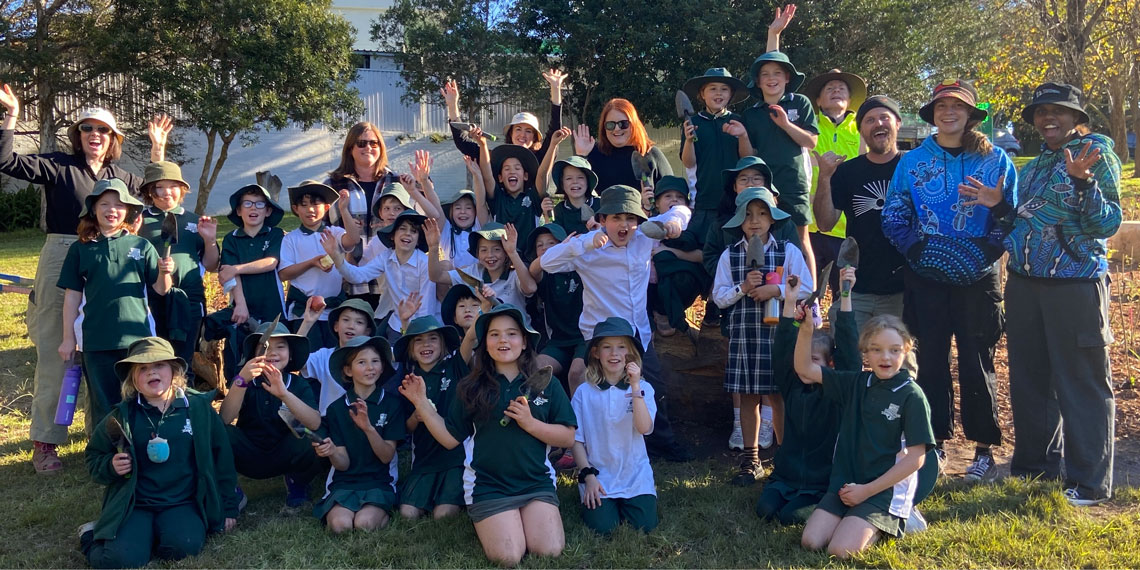Tiny Forest West Pymble

Council partnered with Earthwatch Australia and Bupa to establish Sydney’s first Tiny Forest in Ku-ring-gai.
What is a Tiny Forest?
Tiny Forests are densely-packed patches of local native bushland around the size of a tennis court. These urban wildlife oases have the potential to help us fight pollution and global warming while creating a place for community to gather, learn about and interact with nature.
Tiny Forests use the established Miyawaki planting method that includes soil enrichment, diverse local indigenous plant selection and a dense planting structure. Tiny forests may be small, but they punch above their weight, at least ecologically speaking. They grow up to 10 times faster than natural bushland.
Site map
 |
Map key
1. Control plot - Approximately 60m2 Sydney Turpentine Ironbark Forest species used to compare tree growth rate. This planting has not received additional nutrients in the soil.
2. Tiny Forest - Approximately 200m2 Turpentine Ironbark Forest species providing ecological and social benefits for the community. This area has been enriched with nutrients.
3. Outdoor learning area - Sandstone seating and outdoor education space.
|
Why West Pymble?
The tiny forest site is approximately 320 square metres, including an outdoor classroom and control plot. The West Pymble Village Green is still available for people to kick a ball, walk the dog or enjoy a coffee in the sun. The tiny forest only takes up a small area and screens the oval from the petrol station, improving the amenity for all.
Project partners
Earthwatch, a citizen science organisation founded in 1982, engages communities in research to protect nature. Its Tiny Forests serve as outdoor classrooms where students and locals monitor biodiversity, climate, and soil health, while learning about local ecosystems.
Earthwatch is also collaborating with councils in Lake Macquarie, Adelaide, and Monash, as part of a global network studying the benefits of tiny forests.
Read more about urban greening and biodiversity:"Playbook for Urban Biodiversity" (2024) and "Let’s Scale Up! Urban Greening in the Private Realm: Engaging and motivating community" (2022).
Outdoor classroom
Discover a range of exciting school programs delivered by Earthwatch. Hands-on learning experiences, out of the classroom and into the field, allowing them to work alongside scientists and researchers on real-world environmental projects. It’s hands-on science, right in our own backyard.
How does the tiny forest work?
It may be small, but our tiny forest is packed with life. Here's how we created it:
- Soil is dug out to about a metre and enriched compost, straw, leaves and mycorrhizal fungi are added – creating a forest floor.
- Carefully selected native plants are planted in tight clusters - each square metre includes a tall tree, small tree, shrub and groundcover.
- Plants are staggered to avoid crowding and grow fast, forming a dense, diverse ecosystem.
The result is a wonderful home for insects, lizards and birds, increasing biodiversity in our built- up areas.
What plants have been used?
We are using plant species found within the Sydney Turpentine-Ironbark Forest (STIF), a Critically Endangered Ecological Community.
Council’s nursery is providing approximately 980 native plants and the Indigo Native Nursery are providing a further 490 native species. Nursery volunteers have propagated these seedlings collected from local populations. This ensures the Tiny Forest is suited to Ku-ring-gai’s conditions and the continuation of wild plants.
Download the full list of plants used in our Tiny Forest Tiny Forest Plant List(PDF, 162KB)
Get involved
We invite the community to help plant, care for, and study these tiny native forests. With support from Earthwatch Australia, local schools and citizen scientists are tracking biodiversity, growth, carbon storage, temperature, water flow and soil health - making a real impact.
Become a Tree Keeper
We have a passionate group of local volunteers of all ages. No experience necessary! You will need to visit the Tiny Forest a handful of times a year to do basic maintenance. You can also help collect data through citizen science surveys.
We will provide you with all the information and tools you need. Register your interest hello@earthwatch.org.au.
Tree Keeper reports
These are produced by our volunteers each time they meet and share how the site and its trees are growing.
Tree Keeper Report August 2024(PDF, 267KB)
Tree Keeper Report November 2024(PDF, 16MB)